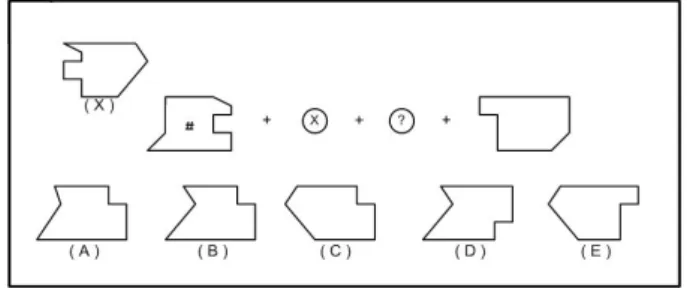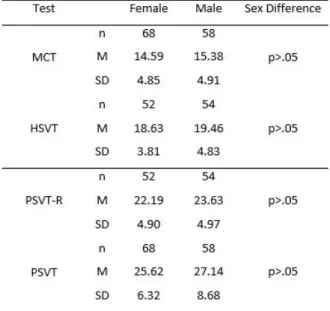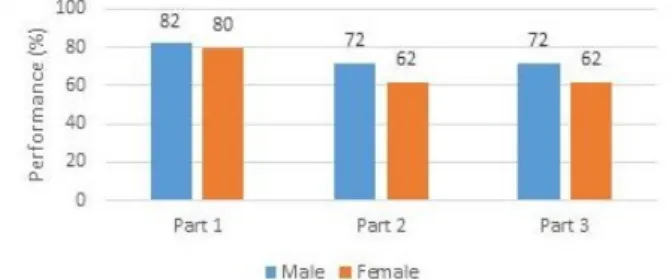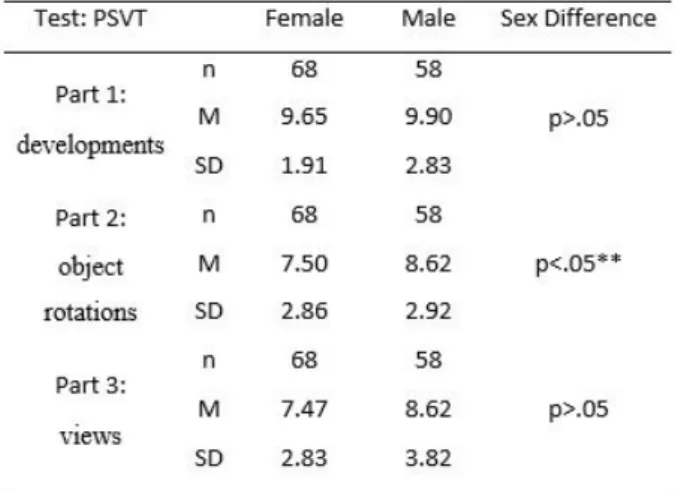Gender differences in spatial visualization skills of engineering students
Rita Nagy-Kondor
University of Debrecen, Faculty of Engineering, Hungary rita@eng.unideb.hu
Submitted May 30, 2016 — Accepted December 14, 2016
Abstract
Spatial visualization skills are very essential in engineering studies. This study investigated the effects of gender in important component of spatial skills among engineering students. A total of 126 first-year engineering stu- dents (68 female, 58 male) completed different spatial visualization tests. In order to analyze the obtained data, means, standard deviations and indepen- dent samples t-test were used.
Keywords:Spatial ability, mathematics education, engineering education MSC:G20, G30, G40
1. Introduction
Spatial visualization skills are essential to success in several disciplines. Spatial thinking has an important role in the teaching and learning of mathematics process.
Previous studies showed that this ability has positive correlations with geometry and mathematics education. (see [2, 40]) According to previous studies students with high scores on a mental rotation test systematically score higher on anatomy examinations (see [44]) and spatial visualisation ability is a predictor for success in technical education and it is very important in engineering training. (see [1, 16, 22, 23, 26, 27]) The skills needed to develop a person’s spatial ability are acquired through programs or activities that teach engineering or drafting. (see [31]) Shea, Lubinski and Benbow (see [35]) state that the intellectually talented adolescents, who has better spatial than verbal abilities are more likely to be found in the field of engineering, computer sciences and mathematics.
http://ami.ektf.hu
265
• Spatial perception: the vertical and horizontal fixation of direction regardless of troublesome information;
• Spatial visualization: it is the ability of depicting of situations when the components are moving compared to each other;
• Mental rotation: rotation of three dimensional solids mentally;
• Spatial relations: the ability of recognizing the relations between the parts of a solid;
• Spatial orientation: the ability of entering into a given spatial situation.
Several studies have indicated that there are various factors effecting spatial ability; one of these is gender. According to Tsutsumi et al. (see [37]) females are much less likely to get high scores in Mental Cutting Test (see [29, 30]). In general, boys have a higher spatial ability than girls which may be caused by biological and/or environmental factors (see [42]). And the related literature shows that there is a significant male advantage on mental rotation tasks at every age (see [32, 45]).
Yet, difference between males and females on those tests are much smaller than those found in mental rotation and spatial perception (see [42, p. 90]). There are conflicting results in the reviewed literature. Previous studies (see [19, 39, 41]) found that there is not a significant difference between male and female groups’
scores in spatial visualization of prospective elementary mathematics teachers. Due to these conflicting results the educators are still interested in gender difference in case of spatial ability.
In the light of the existing literature, the aim of this paper to evaluate MCT, HSVT, PSVT (developments, rotations (without coordinate axes), views) and PSVT-R (with coordinate axes) test results of first-year engineering students in University of Debrecen, with special emphasis on gender differences, in comparison with the international results. Such a comprehensive survey has never been made in our University.
2. Measurement of spatial ability
The measurement of spatial abilities is standardized by international tests, among which the Mental Cutting Test (MCT) is of greatest importance. MCT presents
a 3D object with an imaginary cutting plane and five possible solutions for the cross-section shape. Heinrich Spatial Visualization Test (HSVT), Purdue Spatial Visualization Test (PSVT) and Purdue Spatial Visualization Test – Visualization of Rotation (PSVT-R) are widely used for testing the spatial ability.
Much work has been reported an analysis of MCT (see [1, 16, 37, 38]), HSVT (see [13, 39]) and PSVT-R (see [1, 7, 34, 36]) results of engineering students or prospective mathematics teachers. Most US researchers have used the PSVT-R to measure visualization skills; MCT is widely used in Europe and Japan.
The standard MCT (a sub-set of CEEB Special Aptitude Test in Spatial Re- lations, (see [5])) consists of 25 items. In each item presents a three dimensional object which is to be cut with an assumed cutting plane in perspective projec- tion, and five alternative views of the resulting section (one correct alternative and four incorrect alternatives), resulting from the cut. The students is required to choose the single view that represents the correct section. It was shown by Saito et al. (see [33]) and Tsutsumi et al. (see [37]) that in order to solve the MCT problems, subjects go through three phases of information processing, which are:
• Recognizing the solid from the perspective drawing,
• Cutting the solid by the assumed cutting plane,
• Judging the characteristic quantity of the section, if necessary.
One of paper-and-pencil test was selected to measure spatial visualization abil- ity of prospective elementary mathematics teachers: a reduced version of HSVT (planar geometrical transformations). This test was developed by Heinrich (see [13]) to examine the spatial abilities of engineering graphics students. The origi- nal HSVT includes two major expert skills in spatial visualization: synthesis and decomposition. For each two basic skills she hypothesized that when mental rota- tion was added to these tasks at three hierarchical levels of complexity, this would render the spatial problem solving progressively more difficult (see [6, p. 2]). The original HSVT consists of 48 items divided into 6 scales:
• synthesis without rotation;
• decomposition without rotation;
• synthesis with one-step rotation;
• decomposition with one-step rotation;
• synthesis with two-step rotation;
• decomposition with two-step rotation.
Example items of the test are given in the following figures.1
1Similar items used in the reduced test are given in the light of the examples of Chen (see [6]).
Figure 1: Example item for Synthesis section
Figure 1 expresses an example about the part of “Synthesis”. Synthesize four pieces, adjusting Probe X to fit piece # and selecting one of 5 options A, B, C, D, E to replace the question mark. (see [6, p. 3]) Decompose given pattern three pieces, X + ? + Y, where probes X, Y may need to be adjusted, and after selecting one of 5 options, A, B, C, D, E to replace the question mark. The reduced test includes 15 items for the part of “synthesis”, and 10 items for the part of “decomposition”.
Guay (see [11]) developed the PSVT in 1976 to determine student’s ability to visualize, recognize orthograpic drawings. The PSVT includes three sections:
developments (identification of the figure), object rotations and views. Most re- searchers use only the object rotations portion (PSVT-R). The rotations section shows an object in two different positions. The first object is rotated on the X, Y or Z-axis, to show the rotation pattern. A second object is presented with five alternative views, one represents the second object subjected to the same rotation as the example. In our study coordinate axes were added to the first and second stimulus objects, but they were not added to the five solution choices (see [3]). The first stimulus object was shown in its new, rotated position. Figure 2 expresses an example about the part of PSVT-R (with coordinate axes) (see [3]).
3. Background
On the basis of our experience at the University of Debrecen, the high number of engineering students who fail to meet the requirements of the different foundation and special subjects can be explained by their insufficient secondary school knowl- edge in geometry, mathematics and physics. There are not sufficient opportunities for high school students to learn geometry, number of geometry class hours per secondary school year and especially number of three dimensional type class hours per secondary school year are very few.
Our aim of the introduced of “Basic Knowledge of Natural Sciences” course is to summarise and repeat those parts of elementary and secondary school mathemat- ics, geometry and physics which are necessary as basic knowledge at our Faculty (see [28]). In the syllabus of the subject “Basic Knowledge of Natural Sciences”
there are only secondary school topics, and from these topics only the ones which
Figure 2: Example item for PSVT-R with coordinate axes added (see [3])
are highly important for engineering students. For example, in order to support teaching Descriptive Geometry, there are some topics of secondary school geometry:
Basics of representation; Plane and space geometry; Coordinate geometry. Before they begin their studies, all students participate in this course. On the other hand, at our faculty the teaching of Mathematics is based on course book entitled “Math- ematical Tools in Engineering Applications” (see [25]) to develop the mathematical knowledge. The book follows a new “engineer friendly” approach by demonstrating the application of mathematical tools through problems which typically occurring in the different engineering and economic fields.
4. Methodology
At the University of Debrecen 126 (68 female, 58 male) first-year engineering stu- dents took the tests. Subjects of the study are volunteered to participate and confidential feedbacks were given to those participants who are interested in. The students were recruited after “Basic Knowledge of Natural Sciences” course.
All data were collected by the author during the autumn semester. The test was administered in groups to explain instructions, efficiently. We used a personal information form for gathering data on gender. Standard instructions were given to two samples.
5. Results
Data were analysed using the SPSS statistical analysis program. The performance of the students is presented in the Figure 3.
Figure 3: Results of Spatial Tests
Male students were 4% in MCT, 4% in HSVT, 5% in PSVT-R and 7% in PSVT better than female students on the tasks of spatial tests. The first-year engineering students scored 59.89% in MCT, 75.84% in HSVT, 76.3% in PSVT-R and 71.22%
in PSVT.
According to these results, it can be said that Hungarian engineering students have adequate spatial performance. Means, standard deviations of spatial visu- alization ability and statistical differences of each group are analyzed in terms of descriptive statistics (Figure 4).
Figure 4: Mean scores of each sample and statistical differences
Investigating of each sample’s and all tests’ means and standard deviations, we find that female/male engineering students mean score of MCT is 14.59/15.35 (SD = 4.85/4.91). Female/male engineering students mean score of HSVT is 18.63/19.46 (SD = 3.81/4.83). Female/male engineering students mean score of PSVT-R is22.19/23.63(SD = 4.90/4.97) and mean score of PSVT is25.62/27.14 (SD = 6.32/8.68) (Figure 4). The results of female students did not reach the results of male students in all spatial ability tests. We found that there is not a sig- nificant difference between male and female groups’ scores in spatial visualization in all spatial ability tests.
The performance of the students in PSVT is presented in the Figure 5.
Figure 5: Results of PSVT
Male students were 2% (Part 1), 10% (Part 2) and 10% (Part 3) better than female students on the tasks of PSVT.
Means, standard deviations of part of PSVT and statistical differences of each group are analyzed in terms of descriptive statistics. The results appear in the Figure 6.
Investigating of each sample’s and all part of tests’ means and standard devi- ations, we find that female/male engineering students mean score of PSVT devel- opments is 9.65/9.90 (SD = 1.91/2.83), mean score of PSVT object rotations is 7.50/8.62 (SD = 2.86/2.92) and mean score of PSVT views is 7.47/8.62 (SD = 2.83/3.82) The results of female students did not reach the results of male students in parts of PSVT. We found significant difference (p < 0.05) between male and female groups’ scores in object rotations without axes.
Tasks of object rotation of PSVT focus on the imaginary manipulation of the solid. First task is the identification of the figure; second task is manipulation of mental representations. Many female students have bigger problems with imagi- nary manipulation without axes.
In general, the average scores of the PSVT-R are consistently reported to be around 75% across US four-year engineering universities; many other studies report similar data among engineering students. Results of the MCT test are comparable with an average around 60% for universities in the US, Australia and Europe (see [1, 7, 8, 10, 16, 36]). Spatial visualization skills of first year engineering students at the University of Debrecen are similar to the most engineering students’ results (PSVT-
Figure 6: Mean scores of PSVT of each sample and statistical differences
R is 76.3% and MCT is 59.84%) of international studies. Spatial visualization skills of entering first year engineering students at the Polytechnic of Namibia are significantly lower than those of most students in industrialized countries, but comparable to cohorts of minority engineering students in the US. Ault and John (see [1]) hypothesize that these differences are due to factors of prior experience and educational background.
6. Conclusion
Spatial ability of engineering students is greatest importance in terms of their professional achievement. Yet the results of the survey verify that many students have problems with imagining a spatial figure and therefore to solve the spatial geometry exercises. There are not sufficient opportunities for high school students to learn geometry. It would be very useful in the high schools and in the university training as well, if we devote more time for spatial ability, for summarizing the spatial geometry knowledge, for solving spatial geometry tasks. In general we can conclude that the basic geometry, mathematical and physical knowledge of students, who start their studies at Faculty of Engineering, is insufficient for their further engineering studies. It is very important to detect early the students with lower levels of spatial ability, because later will be negative impact by engineering studies.
The existing literature reports, that males perform better than females on spa- tial tests, especially on mental rotation tasks (see [1, 17, 29, 32, 37]). The results of female students did not reach the results of male students in all spatial ability tests, but we found that there is not a significant difference between male and fe- male groups’ scores in spatial visualization in all tests, excepting part 2 of PSVT,
in object rotations without axes. Many female students have problems with imag- inary manipulation without axes. We hypothesize that these differences in object rotation are due to use of axes in other mental rotation test (PSVT-R). The use of axes helps our female students for example in PSVT-R. It is possible that instead of manipulation of mental representations, female students watched shape and po- sition of two-dimensional figure of solid in the coordinate plane, and thus deduce the solution. So it is useful to use several types of spatial test for measurement of spatial abilities.
In the future this difference can also be investigated in other areas of study.
Based on studies of visualization skills we hypothesize that these differences are due to factors of students’ prior experience and educational background.
Studies suggest that interactive animation and virtual solids are promising tools for training spatial thinking and we can achieve better results in mathematics classes with the use of dynamic geometry systems (see [4, 20, 23, 24, 36, 43]).
GeoGebra was designed to combine features of dynamic geometry software (e.g. Cabri Geometry, Cinderella, Geometer’s Sketchpad) and computer algebra systems (e.g. Derive, Maple) in a single, integrated system for teaching and learn- ing mathematics (see [14, 15]). Budai (see [4]) combined with plane space analogies for development of spatial ability and problem-solving skills in three dimensions of solid geometry. He presented the plane and spatial analogues of coordinate geome- try with the help of GeoGebra, since part of the concept of this software is to show the algebraic and geometric view of the objects in parallel.
How we can help female students to develop their spatial ability, particularly in object rotations and views (and results of PSVT)? In the future it would be useful to focus on task based student interviews to reveal our female students’
spatial problems, to find the reasons and typical mistakes of these female-male difference. Based on the results, as a future study, it is being planned to make special interactive worksheets to develop of spatial ability in collaboration with other researchers and to research the relationships academic success and spatial ability.
References
[1] Ault, H. K., John, S., Assessing and Enhancing Visualization Skills of Engineering Students in Africa: A Comprehensive Study,Engineering Design Graphics Journal Vol. 74(2) (2010), 12–20.
[2] Bosnyák, Á., Nagy-Kondor, R., The spatial ability and spatial geometrical knowledge of university students majored in mathematics,Acta Didactica Universi- tatis Comenianae, Vol. 8 (2008), 1–25.
[3] Branoff, T., Connolly, P., The Addition of Coordinate Axes to the Purdue Spatial Visualization Test – Visualization of Rotations: A Study at Two Universities, Proceedings of the American Society for Engineering Education Annual Conference.
[4] Budai, L., Improving Problem-Solving Skills with the Help of Plane-Space Analo- gies,Center for Educational Policy Studies Journal, Vol. 3(4) (2013), 79–98.
[8] Field, B., A Course in Spatial Visualization,Journal for Geometry and Graphics, Vol. 3(2) (1999), 201–209.
[9] Gardner, H., Frames of mind: the theory of multiple intelligences,Basic Books, New York, (1983).
[10] Gorska, R., Sorby, S., Testing Instruments For The Assessment Of 3-D Spa- tial Skills, Proceedings of the American Society for Engineering Education Annual Conference, (2008).
[11] Guay, R. B., Purdue Spatial Visualisation Test: Rotations,West Lafayette: Purdue Research Foundation, (1977).
[12] Haanstra, F. H., Effects of art education on visual-spatial and aesthetic perception:
two meta-analysis,Rijksuniversiteit Groningen, Groningen, (1994).
[13] Heinrich, V. L. S., The development and validation of a spatial perception test for selection purpopes, Master Science Dissertation, Ohio State University, Columbus, Ohio, USA, (1989).
[14] Hohenwarter, M., Lavicza, Z., Gaining momentum: GeoGebra inspires educa- tors and students around the world, GeoGebra The New Language For The Third Millennium, Zigotto Publishing House, Braila, Vol. 1(1) (2010).
[15] Hohenwarter, M., Preiner, J., Dynamic mathematics with GeoGebra, Journal of Online Mathematics and its Applications, Vol. 7 (2007), ID 1448.
[16] Leopold, C., Gorska, R. A., Sorby, S. A., International Experiences in Develop- ing the Spatial Visualization Abilities of Engineering Students,Journal for Geometry and Graphics, Vol. 5(1) (2001), 81—91.
[17] Linn, M. C., Petersen, A. C., Emergence and characterization of sex differences in spatial ability: a-meta analysis,Child Development, Vol. 56 (1985), 1479—1498.
[18] Maier, P. H., Spatial geometry and spatial ability – How to make solid geometry solid? In: Elmar Cohors-Fresenborg, K. Reiss, G. Toener, H.-G. Weigand, editors, Selected Papers from the Annual Conference of Didactics of Mathematics 1996, Os- nabrueck, Vol. 56 (1998), 63—75.
[19] Manger, T., Eikeland, O.J., The Effects of Spatial Visualization and students’
Sex on Mathematical Achivement, British Journal of Psychology, Vol. 89 (1998), 17–25.
[20] Martín-Gutiérrez, J., Gil, F. A., Contero, M., Saorín, J. L., Dynamic three- dimensional illustrator for teaching descriptive geometry and training visualisation skills,Computer Applications in Engineering Education, Vol. 21(1) (2013), 8–25.
[21] McGee, M. G., Human Spatial Abilities: Psychometric studies and environmental, genetic, hormonal and neurological influences,Psychological Bulletin, Vol. 86 (1979), 899—918.
[22] Nagy-Kondor, R., Spatial ability of engineering students,Annales Mathematicae et Informaticae, Vol. 34 (2007), 113–122.
[23] Nagy-Kondor, R., The results of a delayed test in Descriptive Geometry,Interna- tional Journal for Technology in Mathematics Education, Vol. 15(3) (2008), 119–128.
[24] Nagy-Kondor, R.,Using dynamic geometry software at technical college,Mathe- matics and Computer Education, Fall, Vol. 42(3) (2008), 249–257.
[25] Nagy-Kondor, R., Technical Mathematics in the University of Debrecen,Annales Mathematicae et Informaticae, Vol. 38 (2011), 157–167.
[26] Nagy-Kondor, R., Importance of spatial visualization skills in Hungary and Turkey: Comparative Studies,Annales Mathematicae et Informaticae, Vol. 43 (2014), 171–181.
[27] Nagy-Kondor, R., Sörös, C., Engineering students’ Spatial Abilities in Budapest and Debrecen,Annales Mathematicae et Informaticae, Vol. 40 (2012), 187–201.
[28] Nagy-Kondor, R., Szíki, G. Á., “Basic Knowledge of Natural Sciences”: a new foundation subject at the Faculty of Engineering, University of Debrecen,Horizons of mathematics, physics and computer sciences, Vol. 41(2) (2012), ISSN 1335-4981, 9–17.
[29] Németh, B., Hoffmann, M., Gender differences in spatial visualization among engineering students,Annales Mathematicae et Informaticae, Vol. 33 (2006), 169—
174.
[30] Németh, B., Sörös, C., Hoffmann, M., Typical mistakes in Mental Cutting Test and their consequences in gender differences, Teaching Mathematics and Computer Science, (2007), 385–392.
[31] Olkun, S., Making Connections: Improving Spatial Abilities with Engineering Drawing Activities, International Journal of Mathematics Teaching and Learning, http://www.ex.uk/cimt/ijmt1/ijabout.htm.
[32] Pietsch, S., Jansen, P., Different Mental Rotation Performance in Students of Music, Sport and Education, Learning and Individual Differences, Vol. 22 (2012), 159–163.
[33] Saito, T., Shiina, K., Makino, K., Suzuki, K., Jingu, T., Analysis of Problem Solving Process and Causes of Error in a Mental Cutting Test, Proc. 2nd China- Japan Joint Conference on Graphics Education, Chengdu, China, Vol. 22 (1995), 259–264.
[34] Scribner, S. A., Novice drafters’ spatial visualization development: influence of instructional methods and individual learning styles,Dissertation, Southern Illinois University, Carbondale, (2004).
[35] Shea, D. L., Lubinski, D., Benbow, C. P., Importance of assessing spatial ability in intellectually talented young adolescents: A 20-year longitudinal study,Journal of Educational Psychology, Vol. 93 (2001), 604-–614.
[36] Sorby, S., A New and Improved Course for Developing Spatial Visualization Skills, Proceedings, ASEE Annual Conference, (2001).
Mathematics Education, Vol. 6(1) (2013), 168–183.
[40] Turgut, M., Uygan, C., Spatial ability training via 3D modelling software, In E. Faggiano, A. Montone (Eds) Proceedings of the 11th International Conference on Technology in Mathematics Teaching–ICTMT11, University of Bari, 9-12 July 2013, Italy: Università degli Studi di Bari Aldo Moro, (2013), 292-–297.
[41] Turgut, M., Yenilmez, K., Spatial visualization abilities of preservice mathe- matics teachers, Journal of Research in Education and Teaching, Vol. 1(2) (2012), 243–252.
[42] Yilmaz, H. B., On the Development and Measurement of Spatial Ability,Interna- tional Electronic Journal of Elementary Education, Vol. 1(2) (2009), 83–96.
[43] Yue, J., Spatial visualization by realistic 3D views, Engineering Design Graphics Journal, Vol. 72(1) (2009).
[44] Vorstenbosch, M. A., Klaassen, T. P., Donders, A. R. T., Kooloos, J.
G., Bolhuis, S. M., Laan, R. F., Learning anatomy enhances spatial ability, Anatomical sciences education, Vol. 6(4) (2013), 257–262.
[45] Voyer, D., Voyer, S., Bryden, M. P., Magnitude of sex differences in spatial abilities: a meta-analysis and consideration of critical variables,Psychological Bul- letin, Vol. 117 (1995), 250–270.

![Figure 2: Example item for PSVT-R with coordinate axes added (see [3])](https://thumb-eu.123doks.com/thumbv2/9dokorg/1205698.89961/5.722.203.530.125.378/figure-example-item-psvt-r-coordinate-axes-added.webp)


